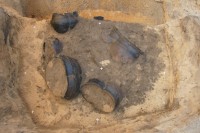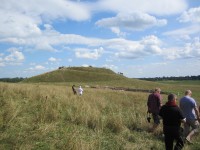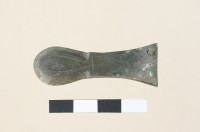 Archaeologists excavating near the village of Skomack Wielki in northeastern Poland have unearthed numerous bronze, iron and pottery artifacts from a settlement dating to the 5th or 6th century A.D. Artifacts from this period in this area are rare, and most of the ones that have been found were discovered in cemeteries.
Archaeologists excavating near the village of Skomack Wielki in northeastern Poland have unearthed numerous bronze, iron and pottery artifacts from a settlement dating to the 5th or 6th century A.D. Artifacts from this period in this area are rare, and most of the ones that have been found were discovered in cemeteries.
Among the most valuable finds are ornaments, brooches and buckles made of bronze, as well as toiletries (tongs) and knives. In one place, archaeologists discovered cluster of entirely preserved 7 ceramic vessels. They differ in size, finish (some carefully smoothed, some rugged), decoration in the form of plastic strips, ornaments made with fingers or engraved. “The whole deposit gives the impression of a specially selected set, although at this stage of research it is difficult to say what was the purpose of selection and of the pit, in which the vessels had been placed” – commented Dr. [Anna] Bitner-Wróblewska.
 Although the population of the area in late antiquity and the early Middle Ages is generally associated with the Sudovian/Yotvingian tribe, archaeologists believe the community in this settlement was a West Baltic tribe called the Galindians who had established connections with peoples to the north, south, west and east of them going back as far as the 2nd century A.D. when Greco-Egyptian astronomer, mathematician, poet and geographer Claudius Ptolemy mentioned them in his Geographia. The range of the ancient tribe was whittled down to a central core in the wake of the upheavals of the late Imperial period. By the 6th/7th century Ptolemy’s Galindians survived as the Old Prussian clan of the Galindis. These artifacts, therefore, are from a significant transitional period in the history of the region.
Although the population of the area in late antiquity and the early Middle Ages is generally associated with the Sudovian/Yotvingian tribe, archaeologists believe the community in this settlement was a West Baltic tribe called the Galindians who had established connections with peoples to the north, south, west and east of them going back as far as the 2nd century A.D. when Greco-Egyptian astronomer, mathematician, poet and geographer Claudius Ptolemy mentioned them in his Geographia. The range of the ancient tribe was whittled down to a central core in the wake of the upheavals of the late Imperial period. By the 6th/7th century Ptolemy’s Galindians survived as the Old Prussian clan of the Galindis. These artifacts, therefore, are from a significant transitional period in the history of the region.
 The pottery vessels, still filled with soil, have been removed to the National Archeological Museum in Warsaw where the contents will be examined under laboratory conditions. The museum is a partner in the Polish-Norwegian Modern Archaeological Conservation Initiative “Archaeology of the Yatvings” which seeks to explore the mutli-period settlements of Baltic tribes (the Yatvings of the title) in the early medieval centers of Szurpiły and Skomack Wielki in Poland’s Warmińsko-Mazurskie region. This is the first archaeological initiative in Poland to prioritize non-invasive methods of investigation like aerial exploration and geophysical surveys to locate and identify archaeological remains and determine how well preserved they are.
The pottery vessels, still filled with soil, have been removed to the National Archeological Museum in Warsaw where the contents will be examined under laboratory conditions. The museum is a partner in the Polish-Norwegian Modern Archaeological Conservation Initiative “Archaeology of the Yatvings” which seeks to explore the mutli-period settlements of Baltic tribes (the Yatvings of the title) in the early medieval centers of Szurpiły and Skomack Wielki in Poland’s Warmińsko-Mazurskie region. This is the first archaeological initiative in Poland to prioritize non-invasive methods of investigation like aerial exploration and geophysical surveys to locate and identify archaeological remains and determine how well preserved they are.
 The project began last year with non-invasive analysis of the sites followed by targeted excavations. It is scheduled to continue through 2016. The ultimate objective, in addition to learning more about the little-known settlement structures of ancient and early medieval Yatvings, is to develop a usable model of heritage protection coupled with archaeology that will give local communities a fuller understanding of their rich history and a preservation-based approach to cultural tourism.
The project began last year with non-invasive analysis of the sites followed by targeted excavations. It is scheduled to continue through 2016. The ultimate objective, in addition to learning more about the little-known settlement structures of ancient and early medieval Yatvings, is to develop a usable model of heritage protection coupled with archaeology that will give local communities a fuller understanding of their rich history and a preservation-based approach to cultural tourism.
Plastic? This article is interesting, but I can’t be the only one who immediately zeroed in on this part: ‘decoration in the form of plastic strips’. What? I thought plastic wasn’t invented until very recently!
It’s possible they mean “plastic style celtic art,” even though the time period for that style doesn’t really line up.
I accidentally made a new comment instead of replying to yours. Plastic can also mean a style of art, which existed long before the material plastic.
In 1500 years from now, some of us will be famous as ‘plastic people’. As we all know, medieval poles invented ‘POLE-esters’ (and of course POLE-vinyl)
Of possibly even more interest, however, is that misterious ‘mound’ that we can see in the photos. Is this hill a slavic ‘gord’ or a (burial?) mound like the ‘Krakus Mound’ ? What did the environment look like ? Were there swamps or marshland ?
Unfortunately, not an awful lot seems to be known for early medieval Poland: Franks in the West against a whole lot of avar tribes with slavic and eastern germanic ones in the East and a lot of migration.
Oh, OK. Thanks for replying! I’ve never heard of that before *goes off to research*
To weigh in on the “plastic” issue, the word “plastic” is often also used to mean “malleable” or “ductile.” For a while, this meaning was heavily taught to people learning English as a secondary language, so it is alive and well in the translation communities, making that a likely reason for the word choice here.
“Malleable” also makes sense in context. The decorations otherwise discussed are “etched” or “made by fingers,” which tend to indicate either indented or pinched out decorations. To add raised relief without altering the underlying structure of the clay vessel (which pinching would do), one could add ductile strips of clay shaped elsewhere and then pressed and slip-joined onto the pot prior to firing.
:blush: :giggle: 😎
Ah, good old translatorese….
In the picture filenames the word ‘brown’ means ‘bronze’, while the ‘plastic’ means the material was worked in some way, including being carved, to achieve a change in shape.
I read a lot of texts written by archeologists around the globe, and you can often tell where they are from by how the use English. Interestingly, those from Israel tend to use the same forms as those from Poland, presumably those who emigrated there from Poland after WW2 took their English learning techniques with them 😉